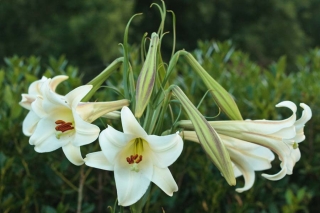 uite a few of the blooms I have featured on Fridays recently have been called “lily” but have not been true lilies. Well, today you get the real deal. There are about 90 species in the genus Lilium, probably the most famous among them being the Easter lily, Lilium longiflorum. They typically show up as attractive potted plants around the celebration of the resurrection of Christ. The pure-white blossoms symbolize the spotless Lamb of God as no other can. A native of Japan, it naturally blooms around November. It has to be artifically “forced” to bloom at Easter.
uite a few of the blooms I have featured on Fridays recently have been called “lily” but have not been true lilies. Well, today you get the real deal. There are about 90 species in the genus Lilium, probably the most famous among them being the Easter lily, Lilium longiflorum. They typically show up as attractive potted plants around the celebration of the resurrection of Christ. The pure-white blossoms symbolize the spotless Lamb of God as no other can. A native of Japan, it naturally blooms around November. It has to be artifically “forced” to bloom at Easter.
This week’s pic is of a near relative of the Easter lily, the Formosa lily, Lilium formosanum, a native of, you guessed it, Taiwan. It was introduced to the west in the late nineteenth century. If all you saw was the bloom, you might think it to be that of an Easter lily, except that the trumpet is a bit longer. This is no mere potted plant, however; no escapee from the parlor, growing outside for the summer. This is the giraffe, the giant redwood, of the genus Lilium, in some cases reaching six or seven feet in height. Click on the picture and notice the foliage in the back ground. That is a six-foot holly hedge. Talk about back of the flower border; this one is made for it. In fact because the plant in bloom is so tall it really needs a fence to grow up against for support in windy areas. Have you ever known Oklahoma not to be windy? It’s kind of like asking “Is the Pope Catholic?” I’m saying stake it to something if you don’t want to be sad.
Only requiring the afore mentioned support, the Formosa lily is very easy to grow, readily started from seed. If you start the seed early enough in the spring, it usually blooms the first season, an uncommon feat for most perennials. In fact, Formosa lily can become quite a nuisance if you don’t cut and remove the quite attractive seed pods before they split open in the fall, scattering the many seeds everywhere you don’t want them to sprout. In just one year the front of your flower border will look just like the back. Blooming a few weeks in July and August, the Formosa lily is a joy to see. Its Easter lily semblance always reminds me of our Savior.
I had to include this shot my wife took of our Don Juan climbing rose. She has fond memories of her grandparents back yard where the same variety of rambling climber engulfed their tool shed. Her grandfather was a avid fisherman, and from time to time he would bury a few fish skeletons at the base of his roses for fertilizer. They were magnificent. When it comes to care, roses are just the opposite of the Formosa lily. They need a fair amount of spraying to keep the bugs and fungi at bay, but it is well worth the trouble.
We had a much-welcomed shower Monday night, into Tuesday, so we will be spending our Saturday out mowing and weed-eating. Hopefully there will be time to enjoy the landscape some too, and rejoice in God’s creation. You get out and enjoy it too, and give thanks. See you Sunday at church.


